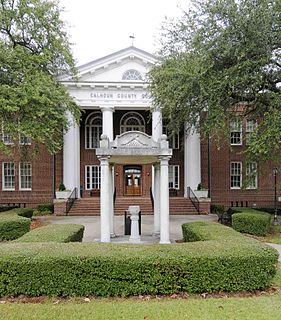
Calhoun County is a county in the U.S. state of South Carolina. As of the 2010 census, its population was 15,175, making it the third-least populous county in the state. Its county seat is St. Matthews.
Fort Motte was developed first as Mt. Joseph Plantation; it was commandeered in 1780 by the British and fortified as a temporary military outpost in what is now South Carolina during the American Revolutionary War. It was significant for its military use as a depot for their convoys between Camden and Charleston, which they occupied. Located along the Congaree River, it is roughly 90–95 miles from Charleston by 21st-century roadways. The British had fortified the big house and surrounds, and it became known as Fort Motte, after Rebecca Brewton Motte, who had been occupying it with her family. During the Patriot Siege of Fort Motte, the plantation mansion was set on fire. The British surrendered at this site.
The Cherokee Path was the primary route of English and Scots traders from Charleston to Columbia, South Carolina in Colonial America. It was the way they reached Cherokee towns and territories along the upper Keowee River and its tributaries. In its lower section it was known as the Savannah River. They referred to these towns along the Keowee and Tugaloo rivers as the Lower Towns, in contrast to the Middle Towns in Western North Carolina and the Overhill Towns in present-day southeastern Tennessee west of the Appalachian Mountains.

Stagville Plantation is located in Durham County, North Carolina. With buildings constructed from the late 18th century to the mid-19th century, Stagville was part of one of the largest plantation complexes in the American South. The entire complex was owned by the Bennehan, Mantack and Cameron families; it comprised roughly 30,000 acres (120 km2) and was home to almost 900 enslaved African Americans in 1860.

Fort Hill, John C Calhoun House and libraries', is a National Historic Landmark on the Clemson University campus in Clemson, South Carolina, United States. The house is significant as the home of John C. Calhoun, the 7th Vice President of the United States, from 1825 to 1850. It is now a house for museums and libraries.
Oakland Plantation may refer to:

The Wedge Plantation, which is also known as The Wedge or the William Lucas House, is a plantation about 5 mi (8 km) east of McClellanville in Charleston County, South Carolina. The plantation is a wedge-shaped property between the Harrietta Plantation and the Fairfield Plantation. The plantation house was built around 1830. It is located off US Highway 17 near the Santee River. It was named to the National Register of Historic Places on September 18, 1975.
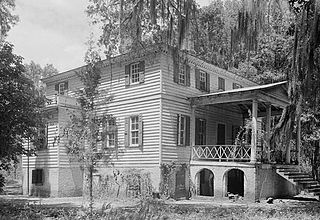
Fairfield Plantation, also known as the Lynch House is a plantation about 5 mi (8 km) east of McClellanville in Charleston County, South Carolina. It is adjacent to the Wedge Plantation and just north of Harrietta Plantation. The plantation house was built around 1730. It is located just off US Highway 17 near the Santee River. It was named to the National Register of Historic Places on September 18, 1975.
Midway Plantation may refer to:

Rebecca Brewton Motte (1737–1815) was a plantation owner in South Carolina and townhouse owner in its chief city of Charleston. She was known as a patriot in the American Revolution, supplying continental forces with food and supplies for five years. By the end of the war, she had become one of the wealthiest individuals in the state, having inherited property from both her older brother Miles Brewton, who was lost at sea in 1775, and her husband Jacob Motte, who died in 1780.
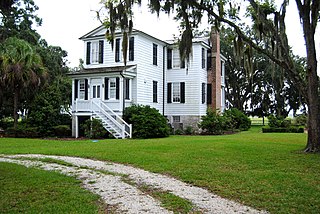
Tombee Plantation is a historic plantation house located on Saint Helena Island near Frogmore, Beaufort County, South Carolina. It was built about 1790–1800, and is two-story, T-shaped frame dwelling. It is sheathed in clapboard and has a gable roof. It features a single-story front portico with four square columns and a two-story balustraded rear porch with six square columns on each floor. Along with Seaside Plantation, it is one of the few surviving antebellum plantation houses remaining on St. Helena Island. The Tombee Plantation property was divided into tracts during the days of the "Port Royal Experiment" in 1862. It remained in the hands of descendants of freed slaves until 1971.
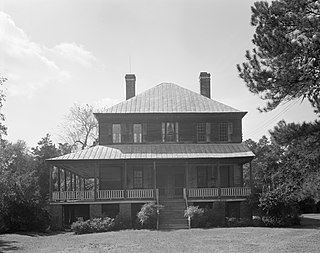
Lawson's Pond Plantation is a historic plantation house located near Cross, Berkeley County, South Carolina. It was built about 1823, and is a large two-story clapboard structure set upon high foundations. It has a hipped roof and features a one-story piazza along the front and left facades.

Lewisfield Plantation is a historic plantation house located near Moncks Corner, Berkeley County, South Carolina. It was built about 1774, and is a 2 1/2-half story clapboard dwelling. It is supported by a high brick foundation that encloses a raised basement. It has a five bay wide verandah supported by six slender Doric order columns. Records show over 100 slaves were held in bondage on the plantation as of 1835.

Midway Plantation is a historic plantation house located near Fort Motte, Calhoun County, South Carolina. The original Midway plantation was built about 1785, although little of this structure remains. The present façade was added about 1859, and is a two-story antebellum frame building with both Greek Revival and Federal influences. The front façade features a pediment and a two-tiered portico with four Tuscan order columns on both levels. The rear wing and porch were added around 1900.
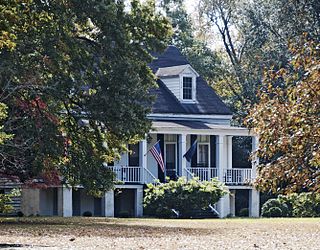
Oakland Plantation is a historic plantation house located near Fort Motte, Calhoun County, South Carolina. It was built about 1800, and is a 1+1⁄2-story clapboard house with two flanking wings set back from the façade. The house sits on a brick foundation and has an enclosed basement. It has a front porch, supported by six square columns. Oakland is still surrounded by farmland, and the house and one outbuilding, the original kitchen, are situated on a one-acre lot.

Col. J. A. Banks House is a historic home located at St. Matthews, Calhoun County, South Carolina. It was built about 1893, and remodeled in 1909–1910. It is a two-story, asymmetrical plan dwelling that incorporates both Classical and Victorian elements. The house features two Neo-Classical colossal Corinthian order porticos and gable pediments with Palladian windows. Also on the property are two one-story, weatherboarded contributing outbuildings: a fowl house and a workshop. It was the home of South Carolina State Representative and State Senator Col. J. A. Banks.

Col. Olin M. Dantzler House, also known as Crutchfield House, is a historic home located at St. Matthews, Calhoun County, South Carolina. It was built about 1852, as a one-story, rectangular, raised cottage with truncated, hipped roof. Also on the property are a barn, several sheds, visitors’ cottage and a pigeon house. It was originally used as a seasonal residence for the Jacob M. Dantzler family of Orangeburg County. The house is the oldest standing residence in St. Matthews.

David Houser House, also known as Oak Grove, is a historic home located near St. Matthews, Calhoun County, South Carolina. It was built in 1829, and is a two-story, rectangular wood frame I-house with a gable roof and stuccoed brick chimney. It has a one-story front porch and rear addition. Also on the property are the original smokehouse, a part of the 19th century Dutch oven, a frame building believed to have once been bedrooms attached to the rear of the house, a barn, a servant's house, a workshop, and the family cemetery where David Houser is buried.

Calhoun County Library is a historic library building located at St. Matthews, Calhoun County, South Carolina. It was built about 1877, and is a one-story, medium-gabled white clapboard structure in the Greek Revival style. It was originally built as a residence, but was adapted for use as a county library in 1949. The front façade features a three-bay, square-columned entrance porch, with smaller porches of similar design on the flanking wings. The library is one of St. Matthews' oldest buildings.

Puritan Farm, also known as Keitt-Whaley-Pearlstine House, is a historic plantation house located near St. Matthews, Calhoun County, South Carolina. It was built between 1820 and 1825, and is a large white two-story clapboard frame I-house. It has a pedimented second floor porch addition, two connecting rear wings, and a full-width front porch with six square columns. The main block of the house is one-room deep with a central hall on each floor. The house was the residence of Congressman Laurence M. Keitt, a leader of the South Carolina secessionist movement. Keitt was born in this house in 1824 and maintained it as his residence until his death in 1864.




















